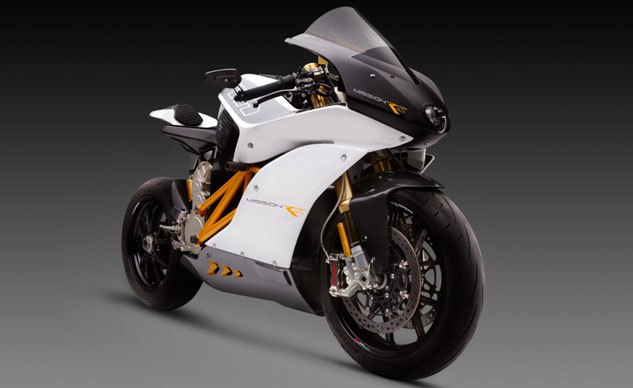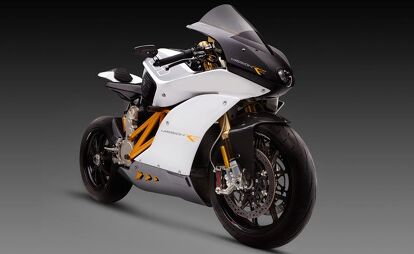2013 Mission Motorcycles RS - First Ride

Electric superbike does not disappoint
In May we published on the Motorcycle.com news blog about Mission Motorcycles coming to market with a production version of the Mission R and Mission RS electric superbikes – virtually the same motorcycles Steve Rapp rode to a convincing victory during the TTXGP races at Laguna Seca two years ago, setting a lap time just 10 seconds slower than a MotoGP machine.
To refresh your memory, here are the important specs to know about this potentially game-changing superbike:
| Mission Motorcyles RS Specs |
|---|
| 120kW motor, pumping out 160 hp and 120 ft.-lb. of torque, according to Mission |
| Three battery packs are available: 12kWh, 15kWh and 17kWh |
| Chassis designed by James Parker – the man who invented the RADD front suspension system in the 1980s |
| An advanced electronics package featuring traction control – the first among production electric motorcycles |
| Brembo brakes |
| Ohlins suspension |
| Carbon or magnesium wheels (depending on spec) |
| 150 mph top speed, 0-60 mph in under three seconds, and the kicker – 140 miles of real-world mileage (with the 17kWh battery) |
| Using a level 2 J1772 charging station and the twin charging system which boosts charging capacity to 9kW, batteries can refill in under an hour |
Although we haven’t had a chance to test the bike and put it through its paces, friend of Motorcycle.com and frequent guest tester, Kaming Ko, recently had a chance to throw a leg over the Mission Motorcycles RS shortly after Tonight Show host Jay Leno rode it.
Ko’s resume is extensive, having raced both two- and four-wheel gas-powered machinery at a high level for three decades. He came back raving about the Mission RS, which is particularly surprising considering he’s been a big critic of electric motorcycle performance all these years.
As brutal as the Kawasaki ZX-14’s acceleration is, each split second required to shift gives a momentary pause to gather your thoughts. Because the Mission is only a single speed, once you open the throttle, “the acceleration never stops!” says Kaming. “I got on and said ‘holy sh*t!’ I was trying so hard just to hang on.”
Kaming’s utter shock and awe with the power delivery mirrors the reaction I had when I rode the Lightning e-Superbike last year. Compared to the Mission, the Lightning comes equipped with “just” a 12kWh battery, with a 14kWh battery option. A 22 kWh battery is apparently in the works.
As for power, Lightning founder and President Richard Hatfield claims the Chevrolet Tahoe Hybrid motor used in his bike puts out more than twice the torque of a Suzuki GSX-R1000. He purports something near 170 ft-lb of twist.
Both machines are well over the 500-pound mark, though exact numbers haven’t been disclosed. From a performance standpoint, both machines offer incredible acceleration and impressive handling, but there’s no hiding the weight penalty each carries.
From there, however, the Mission appears to be a class above the Lightning with its numerous electronic gadgets and gizmos, not to mention the first-class customer support. However, the Lightning’s base price begins at a more reasonable $38,000.
Parker and the design team benchmarked the Suzuki GSX-R1000 when finalizing the Mission’s chassis geometry, and after riding it through the Angeles Crest Highway, Ko reported the RS flicked into turns quickly and responded like a “well setup GSX-R1000 superbike, only heavier.” We expected it to feel heavier, but were surprised about the handling comment considering the Mission’s 58-inch wheelbase is almost three inches longer than the Suzuki.
Otherwise, Kaming couldn’t stop raving about the power and acceleration from any speed, likening it to being “dropped from a rollercoaster.” He liked not having to worry about being in the correct gear for a corner and relying on the broad torque to simply dart him away to the next turn.
His time aboard the RS was short, so he didn’t get to test the mileage claims or fully experiment with the traction control, GPS or the myriad of other rider aids and techno wizardry, but needless to say he was impressed and has vaulted the Mission near the top of his Christmas wish list.
The particular model Kaming rode featured the GP kit, which retails for a staggering $72,500 and includes the FGR200 GP-spec Ohlins fork, TTX36 MkII shock, MotoGP-spec Brembo calipers mated to WSBK-spec rotors and Marchesini magnesium wheels. If that’s of no interest to you, the standard RS, of which only 40 will be made, will cost about $57,000 and still feature carbon wheels, Ohlins suspension, and Brembo brakes.
Each Mission Motorcycle is designed and built in San Francisco and is delivered directly to customers. Kaming reports a warranty ranging from five to seven years is also provided (exact length has yet to be determined), and should the need for software fixes or updates be required, Mission can access the ECU remotely to make the changes. For mechanical issues, Mission says they’ll send a technician directly to your door.
Judging by the report from the one-time e-bike hater, we can’t wait to get our hands on the Mission. We’re trying our best to arrange some seat time on one, and when we do, we’ll deliver a more thorough evaluation of what’s sure to be the new benchmark for electric motorcycle performance.
For now, you can visit the Mission Motorcycles website for more information.

Troy's been riding motorcycles and writing about them since 2006, getting his start at Rider Magazine. From there, he moved to Sport Rider Magazine before finally landing at Motorcycle.com in 2011. A lifelong gearhead who didn't fully immerse himself in motorcycles until his teenage years, Troy's interests have always been in technology, performance, and going fast. Naturally, racing was the perfect avenue to combine all three. Troy has been racing nearly as long as he's been riding and has competed at the AMA national level. He's also won multiple club races throughout the country, culminating in a Utah Sport Bike Association championship in 2011. He has been invited as a guest instructor for the Yamaha Champions Riding School, and when he's not out riding, he's either wrenching on bikes or watching MotoGP.
More by Troy Siahaan









































Comments
Join the conversation
Staggering performance. Very cool. Bonus - the cops will never hear you coming on that thing.
for me this is the most interesting thing happening in motorcycles. On this trajectory it looks like there will soon be powerful electric bikes with a 1,000 km range that recharge in a few minutes. When that happens they will probably start to dominate the market. I just need a bit solar panel on my house to charge it up....